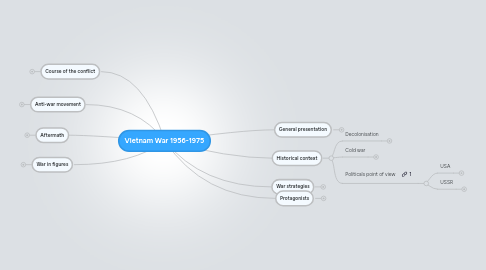
1. Anti-war movement
1.1. In the USA
1.1.1. The opposition begin against Vietnam war in the US (1967)
1.1.1.1. The war were not understanding by young americans
1.1.1.2. A lot of people demonstrated in a lot of American city
1.1.2. Huge "sit-in" on Washington D.C. (May 3,1971)
1.1.2.1. 500,000 protesters (hippies, conscientious objectors and veterans)
1.1.2.2. Pacific demonstration
1.1.2.3. Arrest of 7000 protesters
1.1.2.4. Convince Nixon to leave Vietnam
1.1.3. Jane Fonda arrives in North Vietnam (July 8,1972)
1.1.3.1. 2 weeks on Hanoi, in communists land
1.1.3.2. On "Radio Hanoi" she urge American GIs to stop bombing North Vietnam
1.1.3.3. Shows that even the celebrities were involved
1.1.3.4. Denounced by american politics
1.2. An international movement
1.2.1. Many demonstration in the rest of the world
2. Course of the conflict
2.1. Timeline http://www.dipity.com/s47/Vietnam-War/?mode=fs#timeline
2.2. Most important events
2.2.1. The Gulf of Tonkin resolution (Aug 7, 1964)
2.2.1.1. 5 days after the Gulf of Tonkin incident
2.2.1.1.1. Exchange of fire between American and North Vietnamese ship
2.2.1.2. This text give to president the right to declares war to North-Vietnam
2.2.1.3. Magazine Life reveal 7 years after that all the operation were planned by US government to declare war. The documents who proved that are the Pentagon papers
2.2.2. Operation Rolling Thunder (Mar 2, 1965)
2.2.2.1. Massive aerial bombardment campaign
2.2.2.2. 4 objective
2.2.2.2.1. Improve the moral of South Vietnamese troops
2.2.2.2.2. Convince North Vietnam to stop his help to Vietcong
2.2.2.2.3. Destroy air defenses
2.2.2.2.4. Destroy North Vietnamese transports
2.2.2.3. Aftermath
2.2.2.3.1. Most important air/ground battleof the cold war
2.2.2.3.2. 43 000 tons of bomb dropped on Vietnam
2.2.2.3.3. 938 airplanes lost
2.2.2.3.4. North Vietnam lose 52 000 soldiers and 180 000 civilians
2.2.2.3.5. Strategic failure, the objectives were not reached
2.2.3. The Americanization and US escalation (1965 to 1968)
2.2.4. Tet Offensive (Jan 30, 1968)
2.2.4.1. Article from the New York Times: http://www.nytimes.com/1988/01/31/world/tet-offensive-turning-point-in-vietnam-war.html
2.2.5. My Lai massacre (Mar 16, 1968)
2.2.5.1. Summary by the New york Times: http://www.nytimes.com/2003/04/07/opinion/l-the-my-lai-massacre-124419.html
2.2.5.2. Newspaper article about Hugh Thompson, helicopter pilot who try to save My Lai victims: http://www.nytimes.com/2006/01/07/national/07thompson.html?_r=0
2.2.6. Vietnamization and U.S. Withdrawal (1969 to 1973)
2.2.6.1. Due to Nixon's secret plan
2.2.6.2. Replace american soldiers by South-Vietnamese soldiers
2.2.6.3. The American forces coming home
2.2.7. The Cease-fire (Jan 27, 1973)
2.2.7.1. Paris Peace Accords
2.2.7.2. The cease-fire concern the US army and mean the totally withdrawal of american troops
2.2.7.3. Embodiment of politics of "Vietnamization"
2.2.8. The Fall of Saigon (Apr 30, 1975)
2.2.8.1. Saigon was South Vietnamese capital city
2.2.8.2. The fall of Saigon cause the Operation Frequent Wind, that is to say the evacuation of American embassy.
2.2.8.3. Victory of communism (Vietcong + North Vietnam)
2.2.8.4. Unification of Vietnam, who became the Socialist Republic of Vietnam
2.3. My Lai massacre
3. War in figures
3.1. USA
3.1.1. The numbers of troops engaged rose to 535.100 in 1968
3.1.2. 2.9 million Americans went to Vietnam for a one-year tour
3.1.3. 58.000 Americans died and 2.400 missed in action
3.1.4. 303.700 were wounded
3.1.5. 100.000 came back with physical disabilities
3.2. South Vietnam
3.2.1. Soldiers
3.2.1.1. 254.000 died
3.2.1.2. 783.000 were wounded
3.2.2. Civilian
3.2.2.1. 430.000 died
3.2.2.2. 1.000.000 were wounded
3.3. North Vietnam and Vietcong
3.3.1. 1.027.100 died
3.3.2. There is no data for there wounded
4. Aftermath
4.1. For american prestige
4.1.1. Defeat for the capitalist
4.1.2. Effect on American foreign policy
4.1.3. Damage US image in the world
4.2. For american people
4.2.1. A national trauma
4.2.1.1. A lot of movies about Vietnam
4.2.1.2. A strong pacific movement
4.2.1.3. Every conflict after that reminds Vietnam
4.3. For American soldiers
4.3.1. Cancer for average 50 000 ex-soldiers because of "Agent Orange"
4.3.2. Many veterans suffered of Post traumatic Syndrome
4.4. For Vietnam
4.4.1. Many children contract malformation owing to "Agent Orange" and napalm.
4.4.2. A lot of Vietnamese leak communism and emigrate to USA.
4.4.3. A domino's effect were created in Indochina, Cambodia and Laos known communist government after Vietnam war
5. General presentation
5.1. Glogster: http://www.glogster.com/theophile/flypaper-glog-by-theophile/g-6l0ti39plrf6cr4js2c1ha0
5.2. Tagxedo: http://www.tagxedo.com/app.html?url=azs&shape=Classic&orientation=Any
6. War strategies
6.1. Americans
6.1.1. Napalm
6.1.2. Heavy bombing campaign
6.1.3. "Agent orange"
6.1.3.1. Used for :
6.1.3.1.1. Destroys North Vietnamese crops
6.1.3.1.2. Clear the jungle around American military base
6.1.3.1.3. Prevent enemies to hide
6.1.3.2. Repercussion
6.1.3.2.1. Very toxic for humans
6.1.3.2.2. Lot of problems with children malformation
6.1.4. Weapons more sophisticated than their enemies
6.1.4.1. Helicopters "Huey"
6.1.4.2. Fighters bombers
6.1.4.3. Modern weapons
6.1.4.4. Aircraft carriers
6.2. Vietcong
6.2.1. Guerilla strategy
6.2.1.1. Tunnels
6.2.1.2. Traps
6.2.1.3. Snipers hiding in the jungle
6.2.1.4. Attacks in South Vietnamese cities
6.2.2. Armed by USSR
7. Historical context
7.1. Decolonisation
7.1.1. End of Indochina War against France
7.1.1.1. Creation of 3 States
7.1.1.1.1. Cambodia
7.1.1.1.2. Vietnam
7.1.1.1.3. Laos
7.2. Cold war
7.2.1. 2 blocs
7.2.1.1. Communist group
7.2.1.1.1. USSR
7.2.1.1.2. China
7.2.1.1.3. Warsaw Pact's members : http://en.wikipedia.org/wiki/Warsaw_Pact
7.2.1.1.4. Cuba
7.2.1.1.5. North Korea
7.2.1.1.6. North Vietnam
7.2.1.2. Capitalist countries
7.2.1.2.1. USA
7.2.1.2.2. Western Europe
7.2.1.2.3. Japan
7.2.1.2.4. Oceania
7.2.1.2.5. South America
7.3. Politicals point of view
7.3.1. USA
7.3.1.1. Against communism
7.3.1.1.1. Politics of containment
7.3.1.2. In aid to his allies
7.3.1.2.1. Marshall plan for Europeans countries
7.3.1.2.2. Financial help to other capitalist and anti-communist country
7.3.2. USSR
7.3.2.1. Financial aid to other Communist Party in the world
7.3.2.2. Material and financial help to communist insurgent in the world
8. Protagonists
8.1. USA
8.1.1. Richard Nixon, president (1969-1975)
8.1.1.1. He established the "secret plan"
8.1.2. Lyndon Johnson, president (1963-1969)
8.1.2.1. He was president during the escalated and the bugged down of the war
8.2. South Vietnam
8.2.1. Ngô Đình Diem, president (1954-1963)
8.2.1.1. He was murdered in 1963, with the help of CIA
8.3. North Vietnam
8.3.1. Ho-Chi-Minh, president (1945-1969)
8.3.1.1. He was the communist leader who fought during the two Indochina wars against France and the USA
8.4. Vietcong
8.4.1. The Vietcong, as named as National Liberation Front, was a political and rebellious movement came from South Vietnam and allied to the North.
